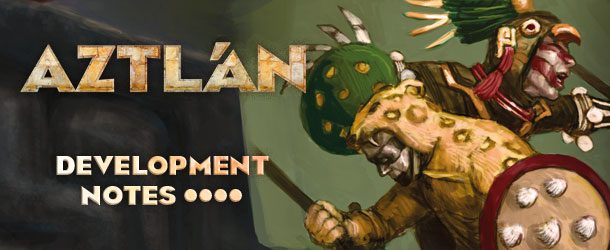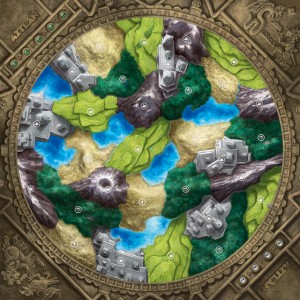Roberto Di Meglio, director of production of Ares Games, speaks about Aztlán, the new game by Leo Colovini that will be released at the Essen “Spiel 2012”. This fourth and last article is about the 2-players variant, Aztec Gods.
As the full Aztlán rules are already available, I will skip talking about game strategies, as you can already read our tips in the rulebook.
As a final post in this series, I want to talk about the two-players “Aztec Gods” rules.
They are indicated in the game as a “variant”. This may seem a little unusual, as they are also a part of the “official” rulebook. However, it was decided to point out this aspect as originally the game was designed for 3 or 4 players only. For a long time we playtested and developed it in this form only, until in conversation with one of our publishing partners, Federico Dumas of Red Glove, we started discussing if a 2-player game was indeed not possible… and if it was possible, how this could work.
Initially, we tested some “basic” variants – just playing head-to-head with more pieces, playing with two tribes for each player… However, we soon found out the main problem with such an adaptation. One of the most interesting mechanics in Aztlán is the decision, after a conflict, whether to co-exist with your opponent or eliminate it.
In a two-players game, the game turned quickly into a bloodbath. There was very little reason to leave your opponent alive, and the game turned into a “pure” wargame. This could have been appealing to some tastes, but really distant from the original spirit of the game (if you are interested, you can easily try this version at home – just start out with 10-12 pieces for each player, and play in the normal way – except that the player who goes second in the first Age cannot play a “9”). The game became too deterministic, and the bluff element was completely lost.
We discussed our ideas with Leo, who in turn involved in the discussion Alfredo Berni, one of his veteran playtesters. Alfredo is a master of “breaking games”, finding ways to twist the rules, and in a matter of minutes he found all the problems with our suggestions. Fortunately, he also provided a brilliant solution. It was a matter of changing perspective on the game. The key idea was to make the elimination of enemy pieces problematic. If you swapped the control of the tribes from one Age to another, suddenly you had to think VERY hard if it was a good idea to remove a pawn – as it will be YOUR pawn in the next turn!
We immediately liked the concept. Sure, it was harder to justify thematically – you were not in control of a specific tribe anymore, and you had the feeling of being some sort of “higher power” playing with the lives of mortals… Hence, the idea of calling the variant “Aztec Gods”.
Developing it was a matter of days – we were in a rush against time, and the game was ready to go to the printer, and we could not miss the deadline to get it ready before the Essen Spiel… Since the very first playtests the variant was working almost perfectly, and there was no need to change any other rule of the game. The only real issue was to balance the number of pawns, to avoid the board being too crowded or too sparse, and to generate the right number of conflicts.
So, indeed, Aztec Gods is a “last minute” bonus that we managed to squeeze into the game – if the idea came a few days later, it could only be presented on the Internet as a “true” variant. But it’s definitely a good addition to have for those times when you don’t have enough friends to play Aztlán with!










